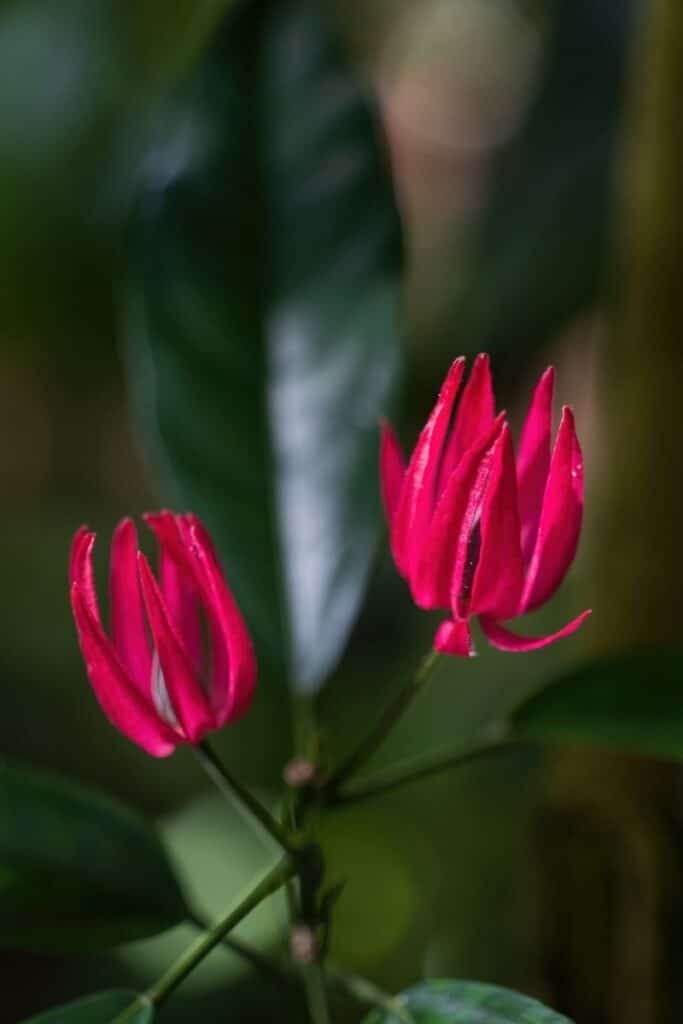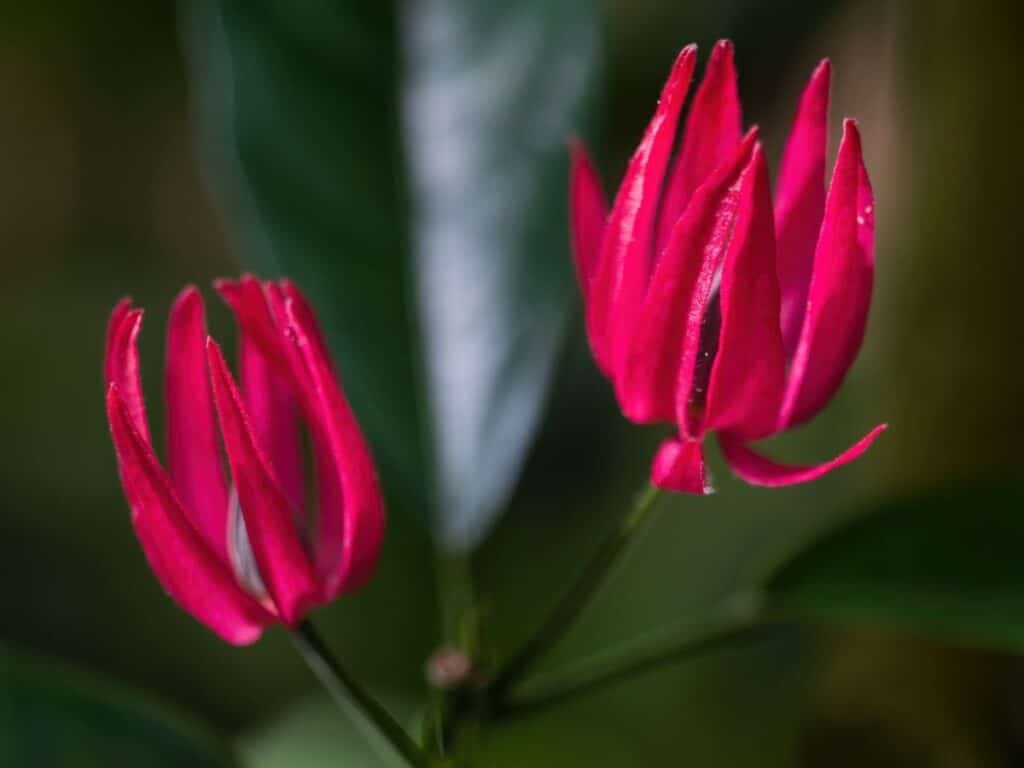With tropical, glossy leaves and pale pink flower bracts that get a deeper, darker red as the plant matures (and don’t forget the purple flowers), the Brazilian candle plant (Pavonia multiflora) is one that you’ve got to consider growing if you’re interested in a more interesting display of color in your home.
Its flowers are unique in that they produce beautiful blooms all year long – no winter dormancy for this houseplant! Its flowers sometimes cover the whole plant. It is closely related to the Hibiscus family and can grow up to five feet tall when grown outdoors – though you can maintain it at a much smaller size when you grow it in a container inside.
Pavonia multiflora has lance-shaped leaves that are green and glossy, typically growing to only about six inches in length. The colors and how they change as the plant grows are beautiful. The buds start out pale pink, turn red as they get bigger, and the actual flower turns a deep purple color.
For a taste of the tropics right in your home, you’ve got to consider this guide to growing and caring for Brailizna candles.
Plant Facts
| Scientific name | Pavonia multiflora |
| Common names | Brazilian candles, Brazilian candle plant, Many Flowers |
| Family | Malvaceae |
| Plant Type | Houseplant |
| Height and Width | 4–8 ft. tall (indoors), 1–3 ft. wide (indoors) |
| Origin | Brazil |
| Flower colors | Purple |
| Foliage color | Dark green |
| Sun Exposure | Full sun to partial shade |
| Soil Type & pH | Moist, well drained, slightly acidic |
| Special features | Low maintenance, light watering, winter-blooming |
How to Grow Brazilian Candles
Brazilian candles can be grown outdoors, but are most often cultivated as houseplants in temperate zones because they prefer hot, humid conditions.
Grown in a container, Brazilian candles have the ability to bloom all winter long provided that the proper conditions are met. In most cases, the plant is only grown as a houseplant with dark blue stamens. Again, it can bloom year-round but its flowering period typically extends from late spring until early fall.
Even before the flower blossoms open, the bracts of the pavonia plant are interesting to look at on their own. This is where the “candle” part of the name really comes into play. However, when the flowers open, you’ll be awarded with gorgeous blooms that look much like hibiscus flowers
It can grow up to four or five feet tall outside but generally only grows to around three feet in a container.
It’s best to plant this specimen indoors in a container since few people will have the right environment for growing it outdoors. It is hardy only in USDA plant hardiness zones 8 to 11. You can purchase a plant at a nursery center or florist’s or you can propagate it from softwood cuttings in the spring. Growing from seed is another option.
Choose a location that gets full sunlight. It can tolerate less light but the more light you have, the more blooms this plant will produce. It can be grown in a sunny window or even a greenhouse or sunroom.
Consider placing your plant outdoors in the summer, regardless of where you live. Not only will it thrive in the bright sun and intense heat of the summer months, but it can also attract butterflies, bees, and other pollinators.
When you plant, be sure to do so in loamy houseplant soil. Keep it moderately moist year-round.

Propagation
You can propagate pavonia plants through cuttings as well as by seed. It is easy to root with softwood cuttings or by air layering, though taking softwood cuttings tends to be the most popular way to grow this plant.
To do this, trim a small, two- to three-inch piece of the stem (look for a stem that is fresh and healthy-looking) during the spring. Plant these in a seed-starting mixture (you can dip each end in a bit of rooting hormone if you’d like, though this is not necessary). Cover the container with a bit of plastic and place it in a location where it will receive indirect sunlight.
Check the cuttings often. After about two or three weeks, you should find that the cuttings have rooted. You can test this out by tugging gently on the plant. Once roots appear, you can transplant your cutting into a larger container.
As mentioned earlier, you can also plant from seed. The flowers become seed pods, from which you can harvest seeds and then sow them in flats filled with the fertile seed-starting mixture.
Soil
The Pavonia Multiflora plant should be grown in soil that is loamy, fertile, and moist. Keep it moist year-round. The soil can be neutral to slightly acidic.
Pruning
The Brazilian candle plant can grow up to four or five feet tall when allowed to grow in a free, unfettered manner. However, indoors, it typically only grows to about three feet tall. Often, you can encourage it to grow in an even more compact form by pruning on a regular basis.
Repotting and Transplanting
Repotting isn’t generally necessary for Brazilian candle plants. The only time you may find you need to do so is if you notice that the blooms have begun to appear less frequently or if its roots have outgrown the confines of the container.
Use a container that is at least two inches wider than the original one, and fill it with plenty of fertile potting soil. At this time, you may want to prune it down to an inch from the soil, too. This will encourage more vigorous growth in the new container.
How to Care for Brazilian Candles
Once you’ve planted P. multiflora in a container in your home, these tips on caring for it should allow you to keep it growing healthy and strong.
Water
Water moderately. If the humidity is high enough, this houseplant is one that can handle quite a lot of dryness at the roots. Just give it an occasional soak (an inch or so of water per week) and it should handle the watering well. Some gardeners report that this plant tolerates even erratic watering with ease.
Sunlight
As tropical plants, Brazilian candles perform best in full sunlight. However, they are surprisingly tolerant of a range of light levels. In fact, you may be able to encourage additional blooming by shaking things up a bit – move the plant from partial sun to full sun and then back – this will cause it to become covered with even more flowers!
It grows in lower light levels, too, but you may find that the leaves are spaced out more and that flowering does not occur as profusely or frequently in full light shade.
When growing this plant indoors, keep it in a south- or east-facing window. A north window will provide it with enough light to stay alive, too, but you won’t get quite as many flowers.
Temperature and Humidity
Brazilian candle plants, as plants that are native to the tropics, prefer a warm and humid environment. That said, it can tolerate periods of lower temperatures and humidity as well.
However, high humidity is key for the best, most optimal growth. Spritz its leaves with a bit of water every now and then, especially in the wintertime.
This is when the air tends to be drier in a home and the leaves may be prone to becoming brittle if they dry out. You’ll notice that they curl down at the edges when they aren’t getting enough water, too. You can also just set the pot you are growing your plant in on a saucer filled with water and pebbles – as the water evaporates, it will add moisture to the air around the plant.
Fertilizer
This plant is not one that is fussy in terms of what sorts of nutrients it receives. However, a bit of nutrients never hurt anyone! You can fertilize prior to planting simply by adding a bit of peat moss to the soil. It likes soil that is slightly acidic, something you might be familiar with if you have already had some experience growing a hibiscus plant (which is a close relative).
You can also just use a general houseplant fertilizer. Fertilize at half strength and consider adding a bit more during active growth. Avoid fertilizing during the winter months – although this plant doesn’t necessarily go dormant as other house plants might, it grows much slower and too much fertilizer can harm it.
Feed once per month during the active growing season. If you find that your plant isn’t blooming the way it should, you can use a formula that has a bit more phosphorus. Just make sure to provide plenty of water while you are fertilizing so you don’t burn the leaves or roots of the plant with heavy applications of fertilizer.
Pest and Diseases
The Pavonia Multiflora plant has few pests and diseases to worry about. When provided with the proper care, it will grow and thrive for many years.
Watch out for aphids. These can damage the foliage and flowers of the plant and attract ants. You can get rid of them with insecticidal soaps or even by handpicking them off the plant. A simple spray of water should help, too.
Mealybugs and spider mites are common on indoor plants, too. Again, these can be controlled with simple measures such as spraying them from the plant or using neem oil. In most cases, you can prevent pests by proper watering and fertilizing.
As far as diseases go, most of the ones you’ll find are related to excess moisture. Root rot is common, so prevent overwatering and instead focus more on maintaining humidity. This is a more important factor for keeping your plant healthy than actual watering.
Common Varieties and Cultivars
P. multiflora isn’t the only type of Pavonia you can grow. Other closely related plants include:
- P. hastata (the Spearleaf Pavonia)
- P. lasiopetala (the Rock Rose)
- P. cymbalaria (Arginine Mallow)
FAQs
What is the common name for Pavonia multiflora?
The common name for Pavonia multiflora is Rose Mallow. To prune Pavonia multiflora, commonly known as Rose Mallow.
How do you prune Pavonia multiflora?
You can remove dead or damaged wood and thin out older, weaker stems. Additionally, shaping the plant by selectively pruning for a balanced form and controlling the height by trimming the tips of branches can help maintain its health and appearance.
Conclusion
If you are interested in growing a plant that never stops blooming – even when it’s small, even when it’s grown indoors, and even in the dead of winter – you have got to consider growing the Brazilian candle plant. These plants are elegant and exquisite to behold, with attractive features that go beyond the beauty of just the flowers themselves.
Now that you know how to grow and care for Brazilian candles, there should be nothing holding you back from cultivating these lovely blooms!
*image by rognar/depositphotos







